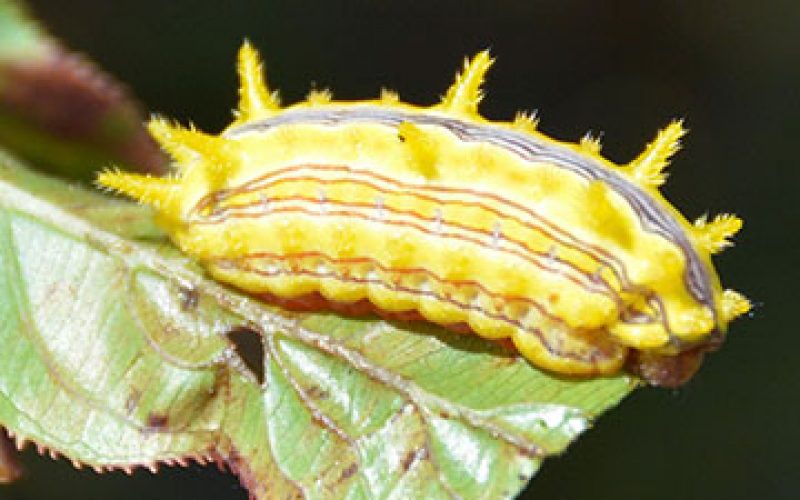Rare stinging caterpillar is real
AMANDA BANCROFT
Making Ripples
It was a beautiful day in the garden neighborhood, and the creatures who dwell there were posing for a photo shoot. Suddenly, my finger started stinging fiercely after I brushed against a bush. On the undersides of the leaves were several bizarre-looking caterpillars. They all had highlighter yellow, orange or red coloration with dark stripes and protruding horns covered in cactus-like spines. Uh oh.
I rushed indoors to do research on “Spikey Banana,” my nickname for the largest and most yellow individual. It turns out that my newly discovered neighbors are stinging rose moth caterpillars (Parasa indetermina). These moth larvae vary in size as they molt and grow but are only about an inch long. They feed on apple, dogwood, hickory, maple, oak, poplar, rose bushes, redbud, oak, hickory, bayberry, wild cherry, sycamore, chestnut, paw paw, pear, plum — and even though no expert source mentions it, sweetspire bushes (Itea virginica), which they’ve spent a week devouring here.
Stinging rose moths are quite rare. According to a 2005 report for the USDA written by James A. Bess, “Parasa indetermina is considered uncommon to rare in most or all parts of its range.” Is it endangered? We don’t know, because there isn’t sufficient data to conclude anything yet, but in New York State, it is considered a species of conservation concern. “Despite more than 500 trap nights of sampling across the southern Ouachitas and Upper Coastal Plain, I did not find this moth in Arkansas,” wrote Bess. “There are recent and historic records of the stinging rose caterpillar from Arkansas, primarily in the northwest part of the state.” Lucky us!
The stinging sensation is caused by urticating bristles, a defense mechanism to deter predators. Plants like the stinging nettle also deploy this tactic, as do tarantulas. Each bristle is hollow and filled with a venom that causes irritation. The spines evolved a weak point, like a skink’s tail, that breaks off when it brushes against something. This releases the poison onto the skin of their unsuspecting victims. Some species have evolved behaviors that increase the effectiveness of this spikey defense. The stinging rose caterpillar rocks back and forth like a ship on stormy seas if you gently prod it with a stick. It’s quite entertaining, so long as you don’t touch it!

Stinging rose moth caterpillars (Parasa indetermina) are so rarely seen, experts don’t even know if they’re endangered. But several are living happily in Amanda Bancroft’s garden.
(Courtesy Photos/Amanda Bancroft)
What would ever eat caterpillars like these? Most of ours were parasitized to death by a foe that remains mysterious to me. Some bird species also eat caterpillars with urticating bristles by catching the caterpillar in their beak and rubbing it against a branch to remove most of the spines.
Spikey Banana and its surviving stinging rose moth caterpillar kin will spin a brown cocoon in which to spend the fall, winter and spring. Next summer, the adult moths will emerge dressed in green and brown fluff. They’ll mate, and the females will lay eggs (hopefully somewhere else) from which tiny caterpillars will emerge and molt, growing larger and spikier with each stage.
To treat a sting, seek medical attention if you have a severe reaction such as blisters or difficulty breathing. Otherwise, you can treat stings at home. Use tape to remove hairs from the skin, then wash the area with soap and water to sluice off any remaining venom. If it itches (mine did not) apply a paste of baking soda mixed with water. Calamine lotion or aloe vera gel helps to soothe the area. I recommend an ice pack to relieve the stinging pain. It helps if your ice pack is shaped like an avocado (as was mine) or perhaps a banana without spikes.
Amanda Bancroft is a writer, artist, and naturalist living in an off-grid tiny house on Kessler Mountain. She and her husband Ryan blog about their adventures and offer tips to those wanting to make a difference at www.RipplesBlog.org.










